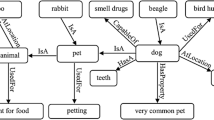Abstract
This paper presents methods and principles for knowledge elicitation and semantics definitions for images and text, respectively, and furthermore introduces a semantic representation scheme that fuses the semantic information extracted from image and text to facilitate intelligent indexing and retrieval for multimedia collection as well as media transformation through their semantic meanings. The method can be deployed for WWW applications such as telemedicine or virtual gallery.
Similar content being viewed by others
References
P. B. Berra and A. Ghafoor, “Data and knowledge management in multimedia systems,” IEEE Transactions on Knowledge and Data Engineering10(6), November–December 1998, 686–671.
M. Betrancourt and A. Bisseret, “Integrating textual and pictorial information via pop-up windows: An experimental study,” Behaviour and Information Technology17(5), 1998, 263–273.
C. Colombo, A. Del Bimbo, and P. Pala, “Semantics in visual information retrieval,” IEEE Multimedia, July–September 1999, 38–53.
J. M. Corridoni, A. Del Bimbo, and E. Vicario, “Image retrieval by color semantics with incomplete knowledge,” Journal of the American Society for Information Science49(3), March 1998, 267–282.
A. M. Glenberg and P. Kruley, “Pictures and anaphora: Evidence for independent processes,” Memory and Cognition20(5), 1992, 461–471.
R. Grishman, Computational Linguistics, Cambridge University Press, 1986.
M. Hegarty and M. A. Just, “Constructing mental models of machines from text and diagrams,” Journal of Memory and Language32, 1993, 717–742.
http://www.cee.hw.ac.uk/~alison/ai3notes/subsection2_4_2_1.html
J. L. Santa, “Spatial transformation of words and pictures,” Journal of Experimental Psychology: Human Learning and Memory3, 1997, 418–427.
L. H. Tang, “Semantic analysis of image content for intelligent retrieval and automatic annotation of medical images,” PhD Dissertation, University of Cambridge, England, 2000.
L. H. Y. Tang, R. Hanka, H. H. S. Ip, K. K. T. Cheung, and R. Lam, “Integration of intelligent engines for a large scale medical image database”, in Proceedings of IEEE Conference on Computer Based Medical Systems, CBMS 2000, Texas Medical Center, Houston, TX, June 23–24, 2000.
L. H. Y. Tang, H. H. S. Ip, R. Hanka, K. K. T. Cheung, and R. Lam, “Semantic query processing and annotation generation for content-based retrieval of histological images,” in Proceedings of SPIE Medical Imaging, San Diego, CA, 20–26 February 2000 (Cum Laude Award).
H. Y. Tang and T. S. Yao, “The lexical semantic driving algorithm based on collocation dictionary,” Journal of Software6, Supplement, 1995, 78–85.
A. Vailaya, A. Jain, and H. J. Zhang, “On image classification: City images vs landscapes,” Pattern Recognition31(12), 1998, 1921–1935.
Author information
Authors and Affiliations
Rights and permissions
About this article
Cite this article
Tang, H.L. Knowledge Elicitation and Semantic Representation for the Heterogeneous Web. World Wide Web 5, 229–243 (2002). https://doi.org/10.1023/A:1020936729808
Issue Date:
DOI: https://doi.org/10.1023/A:1020936729808




